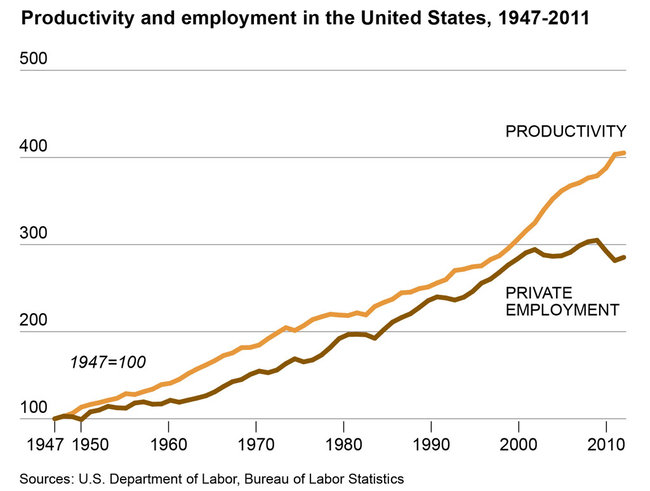TECHNOLOGY – THE REAL REASON JOBS ARE DISAPPEARING
Why Are Jobs Disappearing?
There is a threat that looms larger upon the horizon than many have even considered. Something that far surpasses all other causes of job loss. And this threat emerges from a source that has, for many years, been an instrument of innovation, advancement, and financial prosperity for those who use it. I talk, of course, of technology.
As we march ever closer to the technological precipice, we will take a close look at all that the future holds for this unprecedented transformation. Where jobs will disappear, markets will fail, and economies will fall.
The quickest course to this dystopian future is through corporations that no longer require employees.
Creative Destruction
“Creative destruction” was a term that first appeared in the works of Karl Marx, who recognized that any economy has a natural churn. However, it has come to represent new entities that overcome the most established businesses through revolutionary innovation, superior technologies, or digitally supercharged processes. Uber is the most recognized example of this.
Creative destruction has been seen within markets, where old systems simply become outdated by new ones through advancement that disrupts markets and transforms industries. Prime examples are all around us in the world of today. Digital visionaries such as Uber have replaced taxi drivers and where Airbnb looks to replace hotel chains.
The creative destruction that we’re already experiencing today within our new digital world will be defined by the cutting out of the commercial middleman. Where once stood a corporation between a contractor and a consumer, there afterward will stand a software monopoly. Unprotected contractors will work directly for the consumer–connected through code and managed autonomously by software with little need for a human.
The route to creative destruction that reshapes markets and removes corporate identities that once stood firm won’t be a smooth one. We’re already seeing companies up in arms at the lack of regulation targeting digital application-based services.
Uber is currently fighting off a class action lawsuit which if successful will force Uber to make its drivers employees, costing them millions. The primary reason Uber has reached a $50 Billion valuation is that it pays a lot less for its workforce than a traditional cab company. Having 160,000 drivers classified as independent contractors save the company millions in payroll taxes, allows them to skirt overtime laws, and does not require Uber to reimburse drivers for wear and tear and fuel. If they win, there will be no cap on how big they can grow. Employing drivers this way may even be more profitable than owning a fleet of autonomous cars.
But Uber’s not going to stop there. They just don’t want you to think of them as a taxi service. They want you to be the only name that comes to mind when you need anything.
If companies like Uber can survive, they will reign supreme and bring about a world in which age-old market pricing and competition between companies is replaced by algorithmic price-fixing. Driving down the number of jobs, the salaries of the jobs that do remain, and the protections that had, for so long, safeguarded workers’ rights.
The result of all of this upheaval will be corporations that don’t just exploit labor markets, but that don’t require human labor at all. That have become exactly what our financial institutions demand pure capital monopolies.
Technology And Its Impact On Jobs
The chart above was initially made famous by two MIT academics, Erik Brynjolfsson, and Andrew McAfee, and shows productivity vs. total employment. For decades, the two lines show that as productivity increased so did jobs. The country became richer as a whole during this period.
But during 2000, you see the jaws of the snake open up. Productivity continues to increase, but the number of jobs created stagnates. Brynjolfsson and McAfee call it the great decoupling and they believe that technology is behind it. That technology is allowing companies to become more productive without having to increase the number of jobs.
So how will these technological advances impact our future. Thomas Frey is the innovation editor for THE FUTURIST, and he believes that by 2030 more than 2 Billion jobs (50% of the jobs on the planet) will disappear.
A newer report from the World Economic Forum research paints a bit of a rosier picture with a prediction of 7 million jobs lost by 2020 with 2 million created.
The report states:
“Developments in previously disjointed fields such as artificial intelligence and machine learning, robotics, nanotechnology, 3D printing and genetics and biotechnology are all building on and amplifying one another. Smart systems, homes, factories, farms, grids or entire cities, will help tackle problems ranging from supply chain management to climate change.”
“To prevent a worst-case scenario – technological change accompanied by talent shortages, mass unemployment, and growing inequality – reskilling and upskilling of today’s workers will be critical,” the authors said. “It is simply not possible to weather the current technological revolution by waiting for the next generation’s workforce to become better prepared.”
Something to think about – Google was recently valued at $370 Billion and has a workforce of 55,000. This is 1/10th the number of employees required to run AT&T in the 1960s.
Here are some of the technologies, which are expected to have the biggest impact on jobs.
Robotics
Robotics, alongside globalization, has brought about a decrease in manufacturing jobs from 22% of the U.S. labor market in 1980 to 10% as of 2010 ( 2013). This decline will continue until manufacturing jobs in the U.S. are non-existent.
In the future robotics will have reached such advancement that their characteristics will be increasingly more human-like, removing the need for the previously safe white collar worker.
Japan has already created a first generation robot that is responsible for its owner’s happiness. Even human interaction is under threat.
Justin Reich, a fellow at Harvard University’s Berkman Center for Internet & Society, said,
“Robots and AI will increasingly replace routine kinds of work—even the complex routines performed by artisans, factory workers, lawyers, and accountants. There will be a labor market in the service sector for non-routine tasks that can be performed interchangeably by just about anyone—and these will not pay a living wage—and there will be some new opportunities created for complex non-routine work, but the gains at this top of the labor market will not be offset by losses in the middle and gains of terrible jobs at the bottom. I’m not sure that jobs will disappear altogether, though that seems possible, but the jobs that are left will be lower paying and less secure than those that exist now. The middle is moving to the bottom.”
Artificial Intelligence
Anything you can do I can do better.
The ultimate goal of artificial intelligence is to create a computer mind that can replicate and eventually pass the capabilities of its human counterparts. Simple AI systems are everywhere. From Siri and Cortana in our phones to air traffic control systems. These AI systems perform a single simple task better than any human. But they cannot learn new tasks for themselves. They cannot think for themselves.
But we are quickly moving into the future and the realms of science fiction. The next target for AI will be to create General Artificial Intelligence, which can learn and think like a human. The expectation is by 2050 we will see the first general AI. Some predict it will mark the end of humans; others see it as our savior. One thing we do know is it will be worth billions for whoever gets there first.
Amazon, Walmart, and DHL are busy running their first trials of drone drop shipping; Google has already run extensive tests of their driverless cars, and self-serve checkouts have become commonplace. The future, it seems, is already here, and over the course of the coming three decades, the use of these autonomous systems will become the usual, rather than the exception.
Within 35 years AI will have advanced from the fledgling efforts we see today into machines that can truly reflect human interactions, emotions, and conversations.
Not only will delivery drivers, taxi firms, and part-time workers become redundant, but the jobs that may have otherwise been created for managing and maintaining the technology that has replaced them, will have similarly become a workforce staffed completely by AI robots.
Stowe Boyd, lead researcher at GigaOM Research, said, “As just one aspect of the rise of robots and AI, widespread use of autonomous cars and trucks will be the immediate end of taxi drivers and truck drivers; truck driver is the number-one occupation for men in the U.S.. Just as importantly, autonomous cars will radically decrease car ownership, which will impact the automotive industry. Perhaps 70% of cars in urban areas would go away.
Autonomous robots and systems could affect up to 50% of jobs, according to a recent analysis by Frey and Osborne at Oxford, leaving only jobs that require the ‘application of heuristics’ or creativity…An increasing proportion of the world’s population will be outside of the world of work—either living on the dole or benefiting from the dramatically decreased costs of goods to eke out a subsistence lifestyle. The central question of 2025 will be: What are people for in a world that does not need their labor, and where only a minority are needed to guide the ‘bot-based economy?”
3D Printing
3D printing is achieving incredible things, delivering patterns through the Internet for tools, toys, and even machine parts. Over the course of the next 35 years, they will only become more affordable for all, capable of printing almost anything that can be tangibly mapped out. It is this that will prove to be the final nail in the coffin for manufacturing jobs, not only in the U.S. but worldwide.
Cities with manufacturing plants will become ghost towns as consumers go from purchasing their products in stores to printing them in homes. A major turning point will come when consumers have the capability to print clothing from their homes. Nike is already using 3D printing for prototyping and is looking to expand its use to the general manufacturing of its midsoles. It’s only a matter of time before these advances are complete and in the hands of the public.
Virtual Reality
To fully grasp the impact of virtual reality (VR)on jobs, we have to imagine the technology’s possible future. At this moment, Samsung, Oculus Rift, and HTC are all busy preparing the market for their first virtual reality offerings.
But the VR of today is nothing compared to the VR of tomorrow. By 2050, in just 35 years, virtual reality is expected to be almost seamless (SVR). A user will not be able to differentiate his actual environment from the digital. Some believe this will come in the form of a suit with a sensory tech and visor combination or–even more fantastical–through the insertion of nanobots, microscopic machines, directly into the body. The nanobots will connect directly to brain neurons where they remain dormant until called upon.
According to futuretimeline.net,
“When the user wishes to experience a simulated reality, the nanobots immediately move into place, suppressing all of the inputs coming from the real senses and replacing them with signals corresponding to the virtual environment. If the user decides to move their limbs and muscles as they normally would, the nanobots again intercept these neurochemical signals–suppressing the “real world” limbs from moving, and instead causing their “virtual” limbs to move within the game. This means a user can be sitting in a fixed position, while experiencing a high degree of activity and movement.”
Imagine an average Joe waking up in his one bedroom apartment. The apartment is sparsely decorated except for a chair in the middle of the living room. He puts on his VR suit and visor or activates his nanobots and is immediately transported to a mansion on a beautiful island, accompanied by a beautiful woman. Everything he wants and everything he desires is at his fingertips. No guilt, no rejection, no fear. Scientists say rats would rather starve to death when given the choice between cocaine and food. I’m not saying that Virtual Reality is comparable to crack, but if we ever came up with a rat test for humans, Seamless Virtual Reality will come close.
But how will this impact jobs? Think about it. Our example above has everything he desires in his living room or his body. There is no reason to leave, no reason to buy a larger home, no reason to have a real relationship with a real girl, no reason to go on vacation. In this SVR world, if he works, it can be done within this environment, no reason to go into work and no reason to stop at the local dinner for lunch. The impact virtual reality will have on the economy will be massive.
Conclusion
Society, our financial & educational systems, politics, and technology all have a role in the reduction of jobs. Is this dystopian future written in stone? Maybe not. But now that we’re aware of the possibilities, we should become more active in changing those systems to prepare for these new technologies and provide a better world for all. Technology will either be the angel who sets us free or the devil that tears us apart. We will make the final determination by the choices we make.










